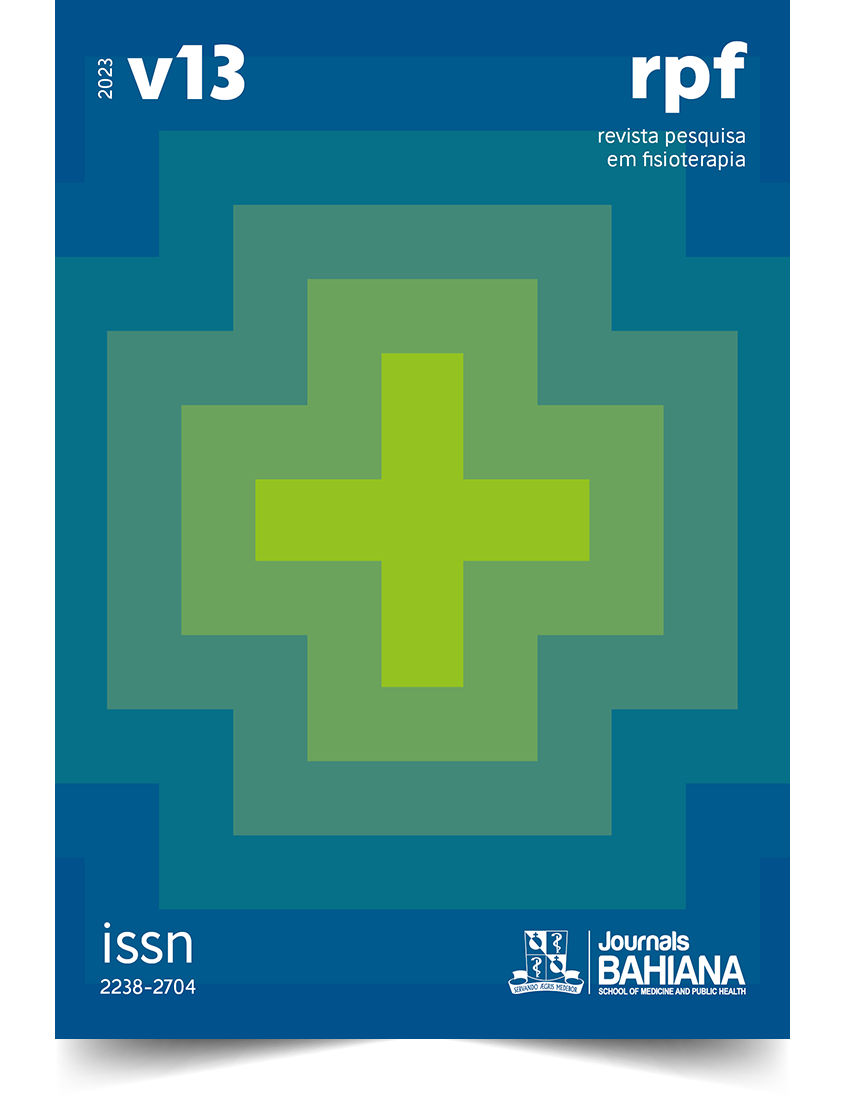Efeitos da dor experimental no desempenho dos músculos flexores do cotovelo após oito semanas de treinamento de força: um estudo piloto
DOI:
https://doi.org/10.17267/2238-2704rpf.2023.e5339Palavras-chave:
Dor Muscular, Exercício, Força Muscular, ReabilitaçãoResumo
INTRODUÇÃO: O treinamento de força tem sido recomendado na reabilitação clínica, bem como no condicionamento físico de atletas. Não é incomum, em ambos os casos, a presença de dor durante a prática; no entanto, até o momento, não há informação consensual em relação aos efeitos da dor muscular aguda nas adaptações ao treinamento de força. OBJETIVO: O objetivo deste estudo piloto foi avaliar os efeitos da dor induzida experimentalmente na adaptação da força muscular após um período de treinamento de 8 semanas. MÉTODO: O estudo incluiu cinco voluntários saudáveis do sexo masculino e não treinados. Os participantes foram submetidos a um protocolo de treinamento de força (3x/semana durante 8 semanas) para os músculos flexores do cotovelo. A dor muscular aguda foi induzida no início de cada sessão de treinamento, por meio de infusão intramuscular de 2,5 ml de solução salina hipertônica (6%) no ventre do músculo bíceps braquial. A força dinâmica máxima (1RM) e a contração isométrica voluntária máxima (CIVM) foram medidas antes e após quatro e oito semanas de treinamento. RESULTADOS: A força dinâmica máxima aumentou, em média, 37,3% e 78,4% após quatro e oito semanas, respectivamente. Entretanto, pouca ou nenhuma diferença foi encontrada na CIVM (-1,7% e -3,0% após quatro e oito semanas, respectivamente). CONCLUSÃO: Após 24 sessões de treinamento de força, com dor muscular aguda induzida a cada sessão, voluntários saudáveis aumentaram sua capacidade de produzir força dinâmica máxima em mais de 75%; entretanto, a força isométrica apresentou apenas pequenas variações negativas.
Downloads
Referências
(1) Kristensen J, Franklyn-Miller A. Resistance training in musculoskeletal rehabilitation: a systematic review. Br J Sports Med. 2012;46(10):719-26. https://doi.org/10.1136/bjsm.2010.079376
(2) Turner MN, Hernandez DO, Cade W, Emerson CP, Reynolds JM, Best TM. The role of resistance training dosing on pain and physical function in individuals with knee osteoarthritis: A Systematic Review. Sports Health. 2019;18;12(2):200-6. https://doi.org/10.1177/1941738119887183
(3) Pareja-Blanco F, Asián-Clemente JA, Villarreal ES. Combined squat and light-load resisted sprint training for improving athletic performance. J Strength Cond Res. 2021;35(9):2457-63. https://doi.org/10.1519/JSC.0000000000003171
(4) Graven-Nielsen T, Svensson P, Arendt-Nielsen L. Effects of experimental muscle pain on muscle activity and co-ordination during static and dynamic motor function. Electroencephalogr Clin Neurophysiol. 1997;105(2):156-64. https://doi.org/10.1016/S0924-980X(96)96554-6
(5) Salomoni S, Tucker K, Hug F, McPhee M, Hodges P. Reduced maximal force during acute anterior knee pain is associated with deficits in voluntary muscle activation. PLoS One. 2016;11(8):0161487. https://doi.org/10.1371/journal.pone.0161487
(6) Henriksen M, Rosager S, Aaboe J, Graven-Nielsen T, Bliddal H. Experimental knee pain reduces muscle strength. J Pain. 2011;12(4):460-7. https://doi.org/10.1016/j.jpain.2010.10.004
(7) Rice DA, Mannion J, Lewis GN, McNair PJ, Fort L. Experimental knee pain impairs joint torque and rate of force development in isometric and isokinetic muscle activation. Eur J Appl Physiol. 2019;119(9):2065-73. https://doi.org/10.1007/s00421-019-04195-6
(8) Farina D, Arendt-Nielsen L, Merletti R, Graven-Nielsen T. Effect of experimental muscle pain on motor unit firing rate and conduction velocity. J Neurophysiol. 2004;91(3):1250-9. https://doi.org/10.1152/jn.00620.2003
(9) Hodges PW, Tucker K. Moving differently in pain: A new theory to explain the adaptation to pain. Pain. 2011;152(3):S90-S98. https://doi.org/10.1016/j.pain.2010.10.020
(10) Ervilha UF, Farina D, Arendt-Nielsen L, Graven-Nielsen T. Experimental muscle pain changes motor control strategies in dynamic contractions. Exp Brain Res. 2005;164(2):215-24. https://doi.org/10.1007/s00221-005-2244-7
(11) Flaxman T, Shourijeh MS, Alkjaer T, Krogsgaard MR, Simonsen EB, Bigham H et al. Experimental muscle pain of the vastus medialis reduces knee joint extensor torque and alters quadriceps muscle contributions as revealed through musculoskeletal modeling. Clin Biomech. 2019;67:27-33. https://doi.org/10.1016/j.clinbiomech.2019.04.005
(12) Stackhouse SK, Sweitzer BA, McClure PW. The effect of experimental shoulder pain on contralateral muscle force and activation. Physiother Theory Pract. 2019;37(11):1227-34. https://doi.org/10.1080/09593985.2019.1686670
(13) Khan SI, McNeil CJ, Gandevia SC, Taylor JL. Effect of experimental muscle pain on maximal voluntary activation of human biceps brachii muscle. J Appl Physiol. 2011;111(3):743-50. https://doi.org/10.1152/japplphysiol.00603.2011
(14) Graven-Nielsen T, Arendt-Nielsen L. Impact of clinical and experimental pain on muscle strength and activity. Curr Rheumatol Rep. 2008;10(6):475-81. https://doi.org/10.1007/s11926-008-0078-6
(15) Schomburg ED. Spinal sensorimotor systems and their supraspinal control. Neurosci Res. 1990;7(4):265-340. https://doi.org/10.1016/0168-0102(90)90008-3
(16) Brown L, Weir J. ASEP procedures recommendation I: accurate assessment of muscular strength and power. J Exerc Physiol [Internet]. 2001;4(3). Available from: https://www.researchgate.net/publication/235782389_ASEP_Procedures_recommendation_I_Accurate_assessment_of_muscular_strength_and_power
(17) Koltyn KF. Exercise-Induced hypoalgesia and intensity of exercise. Sports Med. 2002;32(8):477-87. https://doi.org/10.2165/00007256-200232080-00001
(18) Newcomb LW, Morgan KF, Morgan WP, Cook DB. Influence of preferred versus prescribed exercise on pain in fibromyalgia. Med Sci Sports Exerc. 2011;43(6):1106-13. https://doi.org/10.1249/MSS.0b013e3182061b49
(19) Sørensen TJ, Langberg H, Hodges PW, Bliddal H, Henriksen M. Experimental knee joint pain during strength training and muscle strength gain in healthy subjects: A randomized controlled trial. Arthritis Care Res. 2012;64(1):108-16. https://doi.org/10.1002/acr.20618
(20) Hodges PW, Ervilha UF, Graven-Nielsen T. Changes in motor unit firing rate in synergist muscles cannot explain the maintenance of force during constant force painful contractions. J Pain. 2008;9(12):1169-74. https://doi.org/10.1016/j.jpain.2008.06.012
(21) Nilwik R, Snijders T, Leenders M, Groen BBL, van Kranenburg J, Verdijk LB, et al. The decline in skeletal muscle mass with aging is mainly attributed to a reduction in type II muscle fiber size. Exper Gerontol. 2013;48(5):492-8. https://doi.org/10.1016/j.exger.2013.02.012
(22) Sampson JA, McAndrew D, Donohoe A, Jenkins A, Groeller H. The effect of a familiarization period on subsequent strength gain. J Sports Sci. 2013;31(2):204-11. https://doi.org/10.1080/02640414.2012.725134
(23) Morrissey MC, Harman EA, Johnson MJ. Resistance training modes: specificity and effectiveness. Med Sci Sports Exerc. 1995;27(5):648-60. https://doi.org/10.1249/00005768-199505000-00006
(24) Ebersole KT, Housh TJ, Johnson GO, Evetovich TK, Smith DB, Perry SR. The effects of leg flexion angle on the mechanomyographic responses to isometric muscle actions. Eur J Appl Physiol Occup Physiol. 1998;78(3):264-9. https://doi.org/10.1007/s004210050418
(25) Hortobágyi T, Lambert NJ, Hill JP. Great cross education following training with muscle lengthening than shorting. Med Sci Sports Exerc. 1997;29(1):107-12. https://doi.org/10.1097/00005768-199701000-00015
Downloads
Publicado
Edição
Seção
Licença
Copyright (c) 2023 Venícius de Paula Silva, Valmor Tricoli, Ulysses Fernandes Ervilha

Este trabalho está licenciado sob uma licença Creative Commons Attribution 4.0 International License.
Esta obra está licenciada com uma Licença Creative Commons Atribuição 4.0 Internacional.



